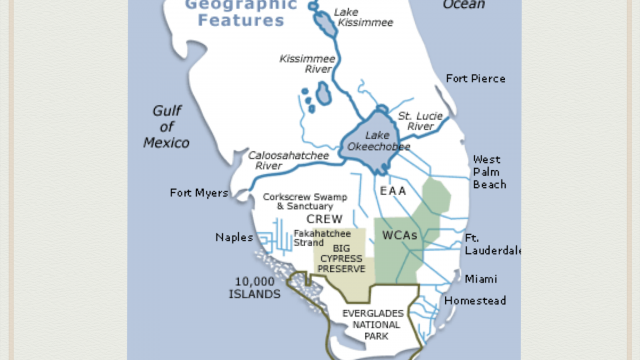Everglades restoration plan a waste of money, green group says

By Marianela Toledo | Florida Watchdog
MIAMI — Government efforts to restore the ecological health of Lake Okeechobee and the St. Lucie and Caloosahatchee estuaries are under fire from Florida environmental groups.
MASSIVE RELEASES: From Lake Okeechobee is harming St. Lucie and the Caloosahatchee River.
The projects on the table are well-intentioned, say several organizations. But the astronomical costs and unrealistic projections won’t restore wetlands and conserve water resources, and are nothing more than a waste of taxpayer money and resources, an environmental group says.
The restoration of the Florida Everglades is part of the multi-billion dollar project — the Water Resources Development and Reform Act — approved by Congress in 2000 to improve, conserve and develop U.S. rivers and harbors.
But some enviros say such projects — particularly those focusing on improving Lake Okeechobee, the Caloosahatchee River Reservoir and the reservoir and storm water treatment area south of the Indian River Lagoon — don’t have sufficient capacity to handle the massive amount of contaminated water flowing from Lake Okeechobee.
“In fact, all the reservoirs to be built under the Comprehensive Everglades Restoration Plan, including those on the East Coast, will not provide enough water storage from Lake Okeechobee to alleviate the massive release of polluted water causing adverse harm to our estuaries,” said Ray Judah, a former Lee County commissioner who now works for the Florida Coastal and Ocean Coalition, a group of organizations working together to conserve, protect and restore Florida’s coastal and marine environment.
When the projects were finalized, the original water-flow projections were based on the 30-year period from 1965 to 1995, a time when the state was exceptionally dry.
But a yearly average of about 455 billion gallons of polluted, brackish water flowing through the St. Lucie and Caloosahatchee rivers — and ending up in estuaries on the east and west coasts of the state — the projections are in need of updating.
“What we need to do is to provide storage of water released from the lake, treat it and then send it south. The reason why it’s a bad idea (the restoration plan) is because right now it is going to the east and west coast and destroying the estuaries, and there is not enough water going to the everglades,” Judah said.
LAND NEEDED: Around 50,000 acres located in the agricultural area of the Everglades, in hands of the Sugar Industry, and is needed to save the everglades and water resources.
According to Judah’s estimates, the Caloosahatchee River Reservoir project alone will cost more than $500 million but store only 55 million gallons of water.
“If you put it in perspective, that will only allow for nine days of water storage,” he said.
Judah thinks buying up agricultural land — namely from “big sugar” outfits — and converting them to wetlands makes more sense.
His solution may be too simple for its own good. In October, state legislators blew a chance to buy up 153,200 acres for $7,400 per acre from U.S. Sugar Corp., the largest producer of sugarcane and refined cane sugar in the United States.
Judah said a purchase of just 50,000 acres at a cost of about $400 million would have been enough to restore wetlands and conserve water resources.
In comparison, the government’s plan would run taxpayers about $16 billion for the Comprehensive Everglades Restoration Program.
Meanwhile, legislators seem intent on keeping up the pace of spending on restoration projects.
Senate Appropriations Chairman Joe Negron, R-Stuart, on Monday designated $171 million for Lake Okeechobee and Indian River Lagoon cleanup.
Florida Watchdog tried to contact the senator, but he failed to respond to our inquiries.
Last week, the U.S. Army Corps of Engineers refused to sign off on the plan, saying it needed additional time to assess feasibility. Corps approval would have given the green light to massive spending on various projects, including a water preserve in Broward County for $433 million, a reservoir along the Caloosahatchee River in Southwest Florida for $297 million, a spreader canal in Miami-Dade County for $89 million and the Biscayne Bay Coastal Wetlands project for $96 million.
“This delay means Congress will be unable to act on (the plan) for years,” said Eric Eikenberg, CEO of the Everglades Foundation, an environmental group. “Once again the Corps is bogged down in its own bureaucracy and determined to follow a trail of red tape that leads to public frustration.”
It’s time to act, Judah said.
“It is important that the South Florida Water Management District, the U.S. Army Corps of Engineers, the Everglades Foundation, all the environmental organizations and the Legislature get behind the effort to create a floodway in the everglades agricultural area.”
“The saltwater intrusion is already affecting Miami because of the sea level rise, so it is important, economically and environmentally” said Darren Rumbold, professor of marine science at Florida Gulf Coast University.
WATCH THE VIDEO HERE:
Contact Marianela Toledo at Marianela.Toledo@FloridaWatchdog.org or on Twitter @mtoledoreporter.







